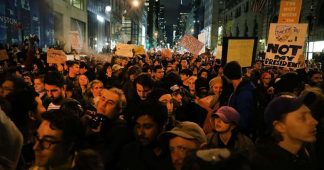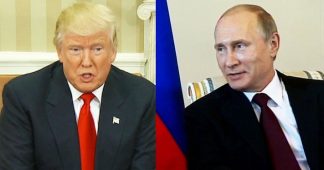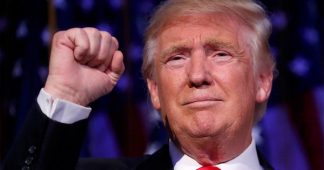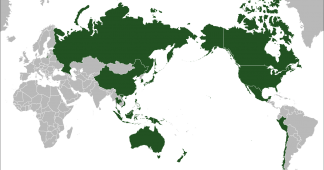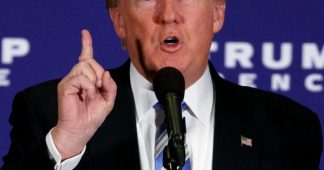By Boris Kagarlitsky
The events currently unfolding in the United States, and discussions of the American Left regarding Trump, remind me of the famous Soviet Odessa joke: a lady stops a car in the street, and asks the driver: “Are you a real taxi?”. The driver’s answer: “Does madam need a ride, or a checkered pattern?”
Numerous activists of the left wing organizations who took part in January protests against the new president of the United States made a clear statement: they don’t want to move anywhere, they don’t need any changes. All they want is a correct discourse; they need a correct checkered pattern on the door of the car.
In the meantime, some changes, currently under way in the US, are not only global in scale, but also fully in line with the demands put forth by the same left in the mass protests they have been organizing in the last quarter of the century. Wasn’t it the Left, who intensely criticized Northern American Free Trade Agreement (NAFTA), arguing (and the criticism turned out to be completely justified) that it would harm American industry, workers and the middle class? Wasn’t it the Left, who by the same token, was condemning the signing of a similar Trans-Pacific Partnership Agreement and was opposed to the forthcoming Free Trade Agreement with the European Union?
President Trump promises to simplify the process of voter registration to facilitate easier access to the voting booth for the lower strata of the society. Openly neglecting his traditional role as the “leader of free world”, he, not only refuses to impose liberal principles on the rest of the world, but also calls NATO obsolete. A few days before taking the oath of the office, he also stated that he stands for the universal healthcare and for curbing the drug prices.
In other words, he repeated the demands of Bernie Sanders, the most left leaning American politician.
Trump also hinted that he is interested in the educational reform, but did not offer any details. If such agenda becomes a reality, we are talking about the most radical social reform in the United States since Franklin D. Roosevelt.
Meanwhile, much of the American left attends the protest marches, organized with the support of the liberal-conservative establishment, invariably repeats any absurd and false accusations against the president and, enthusiastically joins the campaign against his administration, pretending not to understand that the only goal of all these actions is to block social and economic changes in the country. In less than 24 hours after the forty fifth president took office, Washington and other big American cities witnessed mass demonstrations. The public protested not a specific decision of the new Head of the State or against his policies in general, but against his personality. We have time and again been told that Trump is racist, a homophobe and hates women. They tried to accuse him in anti-Semitism as well, but the accusations had to be dropped because of the protests of the Jewish relatives of the president. The protesters never managed to formulate any political demands towards the new occupant of the white House.
Besides, Trump never said anything wrong regarding African Americans, women or gays, except for a private conversation many years ago, when he told his friend about an unsuccessful attempt to molest some lady… But what Trump said, or did not say does not matter. None of the protesters are interested in Trump’s opinions, statements, or even actions. What is really important for them is what the leading New York publications write about him.
In turn, the media showed an unprecedented sympathy for the protests. Many of those who came out in January 2017 to march in Washington and other cities were not protesting for the first time. They have participated in anti-globalization demonstrations or in the Occupy Wall Street movement. Back then, the leading newspapers and TV stations either ignored them or portrayed their actions as antics of bullies and outcasts.
Now, on the contrary, the media is talking with sympathy about what is happening. This is not surprising, because the media establishment itself also plays a crucial role in organizing the protests by working out the ideological basis for the protests, and by disseminating information about the upcoming events and coordinating them.
Some of the Left are weary of all this. But not all. Surprisingly, the majority of “critically thinking” intellectuals turned into easily managed and manipulated mass, without any personal opinions or will. However, even those who are skeptical about the protests, are not inclined to analyze what is happening in class or socio-political categories. All they do is remind their more naive colleagues that the same ladies and gentlemen, who now call on them to protest in the street, resorted to all sorts of dirty tricks just a few months ago to prevent the left candidate Bernie Sanders from winning the Democratic primary.
Such statements are, of course, justified, but they explain nothing. Russian politician Anatoly Chubais expressed the essence of current moment much better while talking about his impressions of the World Economic Forum in Davos. In the words of the leading ideologist of Russian neoliberals, Trump’s victory plunged the crowd at the forum of the global elite into a state of horror. The only encouraging aspect against this backdrop was the speech of the Chinese leader:
“The keynote speaker Mr. Xi Jinping, General Secretary of the Chinese communist party, opened the meeting with a speech which was a brilliant ode to the market economy with energetic appeals to remove the trade barriers, reduce taxes, and even ended with a statement that China is opening up a number of markets that were previously closed. Such a super liberal speech in the best traditions of Chicago school.”
The consensus attitude toward Trump, according to Chubais, can be expressed in the following formula: “He will either reject everything he said before, or he will lead us to a catastrophe.”
This is a fairly paradoxical, but quite logical situation: US is the threat to the world order, while communist China is the last hope of the global bourgeoisie. However, Trump is in no way an opponent of capitalism. He is not a threat to the bourgeois order as such; he is only threatening to its neoliberal version, which established worldwide after the collapse of the Soviet Union. The forty-fifth president of the United States is firmly committed to the principles of protectionism; he will protect US markets and jobs. And, most importantly, he encourages other countries to do the same, not taking into consideration the interests of multinational corporations based in the United States. Worse, he considers these corporations to be the main threat to America. The anxiety of the representatives of transnational financial elite, who gathered in Davos, is understandable. They are really threatened with a catastrophe. After all, the trade agreements that the forty-fifth president of the United States is already starting to undo, in fact, are not about trade. They are about the restrictions of sovereignty of governments, elimination of democratic and social rights of citizens, as well as many privileges provided for large international companies. There is, however, a question: why the American billionaire Donald Trump is not only the enemy of these agreements, but also the driving force behind the alternative, which anti-globalists called for?
The fact is that Trump and his entourage, fabulously rich as they are, do not belong to the multinational corporate and financial elite that has developed and established dominance during the past quarter of a century. Fortunes of Trump and his associates reach 3-4 billion dollars. On the scale of the American and international capitalism of the beginning of the XXI century, these are not big fortunes. Multinational companies control capitals that are ten or more times greater, often managing hundreds of billions of dollars.
Donald Trump is quite a typical representative of medium-size businesses, oriented on the local market and dedicated to the development of real sector.
This part of bourgeoisie quite naturally rebelled against the transnational corporations, which, together with the largest banks, have used its dominant position in Washington in the last quarter-century to change the rules in their favor and to reallocate resources, undermining not only the workers and the middle class, but also a significant part of entrepreneurs. The average business, which rebelled against transnational oligarchies, was forced to look for allies. In turn, the lower classes of society, who for decades suffered from neoliberal policies, enthusiastically joined the revolt. Such alliance will not last for too long, but it is not accidental. The development of industry, internal market, and social policy that strengthens the position of the workers, and gives them confidence is needed in order to restore the workers’ movement, to allow it to gain momentum. In short, we need protectionism.
Historically, the German Social Democracy and Russian working class, which Bolshevicks relied upon, developed precisely against the backdrop of increased protectionist policies. Without industrial growth and development of the internal market, there would be no revolution of 1917.
While workers need jobs and decent wages, businesses operating on the domestic market, need consumers, and the same workers could be these consumers.
Once upon a time, Henry Ford formulated the well-known principle: my workers themselves have to be able to buy cars made by them.
The political embodiment of this principle was the “New Deal” of Franklin D. Roosevelt in 1930s. It is this time of “American greatness” that Trump reminds about to his constituency. But it was not only the era of social transformation and strengthening of national industry; it was also the golden age of American labor movement. The rise of left-wing forces and trade unions in the United States was stopped by the Cold War and McCarthiyte anti-communist purges and persecutions against the radical intelligentsia, which ever since lost touch with the workers, and took refuge in the comfort of the academic ghetto.
In the mid-twentieth century many Western left strategists talked about the need for an alliance with the medium-sized businesses against monopoly capital. Paradoxically, such an alliance formed now spontaneously around the figure of Trump, who is supported by workers, farmers, small entrepreneurs, and provincial intellectuals. Only this bloc is not dominated by progressive left-wing intellectuals, but by a rude and politically incorrect Manhattan bourgeois.
And the intellectuals should blame not Trump, but themselves for this state of affairs – in fact they contemptuously rejected in due time the “outdated” class policy, betting on lobbying liberal establishment and protection of minorities, depicted by them as a kind of socio-homogeneous “suffering” mass .
The fact that these minorities are were often constructed artificially and, in any case, have been divided internally by class differences, was deliberately ignored by intellectuals, because otherwise their strategy to form a block with the enlightened liberals (in other words, the ideological apparatus of financial capital) would prove impossible.
In fact, Trump took to consistently fulfill everything that the Left in the US and Western Europe was talking about for quarter century. Undoubtedly, the ideology of the forty-fifth president of the United States is woven of contradictions, his program, as well as the coalition of social forces which established around it, is transitional, focused only on the decision of one, but absolutely fundamental task – to undermine the rule of the financial oligarchy. There is no way we can support his actions preventing Muslim people from Syria or Iran (just any people) entering the US. There are plenty of other decisions and policies of Trump the Left will never agree with. Yet administration in Washington, finally, appears to be headed, by a politician who is determined to put into practice the demands that the radical activists put forward at least since the time of the protests in Seattle in 1999. And this is really a historic turning point.
What do the radical activists do in this situation? They complain about insufficiently politically correct vocabulary of Trump. They respond to the call of the conservative-liberal media, acting as an infantry for preparation of an anti-presidential coup. Do they themselves believe in what they say? Or are they simply hostages and mercenaries of liberal elite?
Of course, not all American leftists are willing to play this game. Bernie Sanders, for example, is brilliantly trying to sit on two chairs at once.
He refused to boycott the inauguration of Trump and repeatedly wrote letters to the president calling to fulfill the progressive promises made during election campaign. At the same time, Sanders makes appearances at protest demonstrations, stands in front of the opponents of Trump, but, just in case, avoids the leading role in these actions.
This is a very sophisticated tactical maneuvering. There is only one flaw in this tactic: there is no strategy behind it. And sooner or later Bernie will have to make a choice. And the later the choice will be made, the less free and effective it will be.
The liberal establishment has set a goal to achieve an overthrow of Trump in the next year and a half, before the next Congressional elections will be held and the President will be able to fill the Congress with his supporters by mobilizing the grassroots. Impeachment of Trump becomes a key strategic objective for Washington’s elite. They will try to achieve this goal by legal methods, but the overall scenario of destabilization, as we see, is not much different from what the US intelligence agencies would do abroad when they overthrow or try to overthrow governments.
The open conflict, which has already unfolded between Trump and CIA leadership, suggests that everything will happen exactly by such a scenario.
There is, however, one significant difference: the US president is well aware that he faces a potential coup and he knows where the threat is coming from. He will be forced to contribute to the mobilization and organization of the lower classes. In this situation, no one will help him, but the working class.
In this regard, the demand for universal health insurance, supported by 60% of Americans, but unanimously rejected by the representatives from both parties in Congress, could be one of the decisive factors in the political confrontation. It is important for Trump to show that he is in favor of a reform which is clear, necessary and approved by the majority, while the Congress not only blocks his initiatives, but also acts against the American people. These people will have to take to the streets and determine the outcome of the political struggle at a crucial moment when confrontation between the president and the Congress will reach a climax.
In this situation, the Left has a choice: to promote grass-roots organizations and to put forward significant social demands while defending the movement’s independence in relation to the Trump administration, or participate in the conspiracy of the elites as extras, becoming pawns moved by an invisible hand of he elite on the political chessboard.
